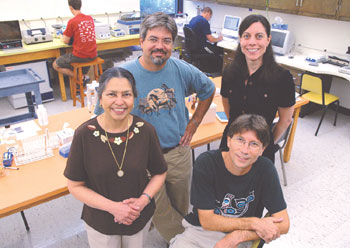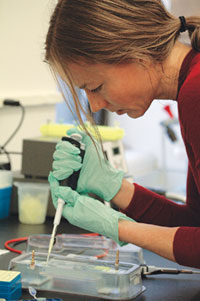University Communications and Marketing
MSU Billings scientists to get university's first-ever patent next week
October 26, 2010
Contacts:
Dr. David Butler, Professor of Molecular Biology, 896-5940
Dr. Kurt Toenjes, Assistant Professor of Molecular Biology, 657-2015
Dan Carter, University Relations, 657-2269
Research could lead to new ways in treating fungal infections, controlling yeast growth
MSU BILLINGS NEWS SERVICES — Cell by cell and molecule by molecule, two Montana State University Billings scientists have made history.
On Nov. 2, paperwork will be issued to allowing the first patent ever for the university. It is work that could lead to new ways in treating fungal infections and controlling yeast growth, but the professors are equally as proud of how undergraduate students have contributed to the research.

“Many students have really put time into this,” said Dr. Kurt Toenjes, assistant professor of molecular biology in the College of Arts and Sciences. “One student did the initial tests for us” when the patent application was filed.
This summer, the scientists received word that the U.S. Patent Office has allowed two of their claims unique to their research. The patent will be issued next week.
The patent pursuit dates back to 2007, when Toenjes and MSU Billings colleague Dr. David Butler, a professor of molecular biology and genetics, refined their collaboration on fungal research. They asserted that they had discovered a new method for controlling yeast growth and a new method for treating fungal infections and found it deserving of patent protection.
“It’s pretty exciting,” Butler said.
The research by Butler and Toenjes, involves a small molecule (BH3I-1) and its ability to block the growth transition of Candida albicans (or C. albicans as it is referred to in scientific journals.) The infection is usually confined to the skin (thrush is one example) and mucous membranes, but in premature babies, AIDS patients and those on immunosuppressive drugs, it can spread throughout the body.
C. albicans is the most common cause of human fungal infections and scientists say it is a major opportunistic pathogen of immunocompromised hosts, including those undergoing chemotherapy and tissue transplants. Studies indicate that up to 90 percent of AIDS patients suffer from infections tied to C. albicans. Approximately 10,000 people die each year from such infections.
The scientific challenge lies in not going too far. If researchers try to stop C. albicans altogether, other valuable cells are destroyed in the process. In normal healthy humans, C. albicans exists in our bodies in a balanced state that does us no harm. The pending patent involves a new way of using BH3I-1 to limit changes in C. albicans so it doesn’t grow out of control.
C. albicans maintains a happy existence inside our bodies as long as adequate amounts of sugars and amino acids keep them happy in a “budded state.” When that gets out of balance, the C. albicans will form tubes, spread unchecked and eventually become an infection. That budded-to-hyphal transition is the place where scientists know the fungi becomes more dangerous.
 Used as an inhibitor, Butler and Toenjes have noted that using BH3I-1 would keep the
fungi in check. They are beginning tests to verify that it does not destroy any other
healthy cells, which is a problem with many antifungal drugs.
Used as an inhibitor, Butler and Toenjes have noted that using BH3I-1 would keep the
fungi in check. They are beginning tests to verify that it does not destroy any other
healthy cells, which is a problem with many antifungal drugs.
The two scientists also believed their work on the novel use of the compound was worth preserving. They worked with Billings registered patent attorney Toni Tease to file for a patent to project their rights and the university’s rights. Tease, who has worked on hundreds of patent applications, also happened to be a former student of Butler’s.
“She knows the science pretty well,” Butler said with a smile. “We’ve enjoyed working with her.”
For both scientists, one of the best parts of the research has been exposing some of their top students to quality research. Undergrads have tested and installed the molecule in different fungal species to test the effectiveness of growth inhibition. It’s detailed work that requires attention and commitment, but also gives students a front-row seat to a potential biological breakthrough.
“The students here are able to make intellectual contribution as well as lab contributions,” Toenjes said. “They have presented their work to scientific colleagues and have won awards for their work. We treat our advanced undergraduate students as faculty at other universities treat their graduate students.”
Some of those former students are now in graduate school in places like the University of Texas, the University of Iowa and the University of Wisconsin.
Butler and Toenjes have received more than $2 million in grants to support their research and top undergraduates are hired to work in the lab while they go to school. Some continue to work in the lab once they graduate as full time technicians.
Students like Kim Eiselein get to run experiments, do genetic work, record data and report results to scientific conferences. She and fellow student Cameron Fox traveled to Washington, D.C., this past year to present findings to scientists from across the United States.
Eiselein, who is pursuing her degree in biology, is interested in understanding how nutrition affects bodies on a cellular level, has done major experiments for Butler and Toenjes and enjoys finding out how the different Candida strains react to the synthesized molecule in the lab.
“I really like the work that can be done on a molecular level,” she said. “I really like being part of something that can be a potential cure for infections.”
The passion and excitement of students is not lost on Butler and Toenjes.
“The patent is cool, but the important thing is the students,” Toenjes said. “They are the real beneficiaries of all of this. For a relatively small town and a relatively small university, they can do what others are doing at Harvard.”
Butler and Toenjes have made invaluable connections with their work. Some of those have led to grant funds to support the research. Some include:
- Research grants from the Montana INBRE (IDeA Networks of Biomedical Research Excellence), funded through the National Institutes of Health.
- A grant from the Center for Development of Immunotherapies to Zoonic Diseases funded by the COBRE (Centers of Biomedical Research Excellence) program of the National Center for Research Resources.
- A grant from the Montana Board of Research and Commercialization Technology.
For a relatively small investment by the university, the grant funding has been a monumental return, Toenjes said.
“For some of these grants, we wouldn’t have gotten them without filing for this patent,” he said.
The MSU Billings scientists will continue their work and will be collaborating with colleagues at MSU in Bozeman on therapeutic studies in animals.
PHOTOS ABOVE: In 2007, MSU Billings professors Dr. Kurt Toenjes and Dr. David Butler started the process of pursuing the first patent for MSU Billings. Toenjes (standing at left) and Butler (seated at right) have learned that the U.S. Patent Office has allowed two of their patent claims on their research that shows new methods of treating fungal infections and controlling yeast growth. The patent will be issued on Nov. 2. Their work has yielded about $2 million in grants and has led to many undergraduates contributing to the research. Working with the scientists patent claims has been Dr. Tasneem Khaleel, (left) dean of the MSU Billings College of Arts and Sciences, and Toni Tease, a registered patent attorney who is also former student of Butler’s.
2nd PHOTO: Undergraduate student Kim Eiselein does work on one of the lab experiments connected to the patent research.
